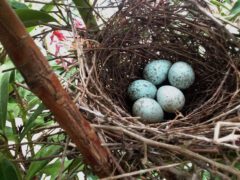Northern Wheatear Photo Gallery
Breeding male (Eurasian)
Adult male in breeding plumage has a black mask, grayish upperparts, black wings and tail, and a buffy throat.
© Lukasz Pulawski / Macaulay LibraryScotland, April 22, 2017Breeding male (Greenland)
“Greenland” adult male in breeding plumage has a darker buff throat and more extensive buff underparts than “Eurasian” adult male.
© Sylvain Reyt / Macaulay LibraryBretagne, April 10, 2023Breeding male (Eurasian)
A small, rather full-bodied songbird. When alert, stands in an upright position, bobs body, and wags tail. Song is a variable mix of whistles, buzzes, crackling sounds, chack and weet calls, and imitations of the alarm calls of other bird species.
© Andrew Spencer / Macaulay LibraryMts'khet'a-Mt'ianet'i, June 07, 2022Not all videos have soundBreeding female (Eurasian)
Adult female in breeding plumage has a faint charcoal mask bordered by a white eyestripe, brownish-gray upperparts, blackish wings and tail, and mostly whitish underparts.
© Tom Auer / Macaulay LibraryAlaska, June 17, 2019Immature
Some immature birds are a rich cinnamon overall.
© Gerard Proulx / Macaulay LibraryQuebec, September 10, 2021Breeding male (Eurasian)
Adult male in breeding plumage has a black mask, gray upperparts, black wings, a black tail, a buffy throat, and white underparts with a variable amount of buff coloring. Frequently found in rocky areas.
© Robert Hutchinson / Macaulay Library‘Asir, March 09, 2022Not all videos have soundJuvenile
Even in unfamiliar juvenile plumage, this species has a distinctive long-legged, short-tailed appearance.
© Andrew Spencer / Macaulay LibraryIrkutsk Oblast, June 22, 2017Breeding male (Eurasian)
Shows namesake white rump and white-and-black tail in all plumages. The black band at the tip of the tail extends to form an inverted “T” on the central tail feathers.
© Frédéric PELSY / Macaulay LibraryArhangay, June 02, 2016Breeding female (Greenland)
Adult breeding female lacks the male’s black mask and has more subdued colors—brownish-gray upperparts and brownish-black wings. Both sexes frequently give chack and weet calls, often in combination.
© Shiloh Schulte / Macaulay LibraryNunavut, July 01, 2014Not all videos have soundNonbreeding male
Typically found on the ground, often perched on rocks.
© Yash Kothiala / Macaulay LibraryEngland, September 08, 2023Nonbreeding adult
Nonbreeding male has a reduced black mask, grayish upperparts, and black wings with buffy feather edging.
© Natthaphat Chotjuckdikul / Macaulay LibrarySukhothai, December 04, 2022Breeding female (Greenland)
Nests in rocky crevices, animal burrows, and human-made cavities (in building crevices, under roof tiles, in pipes, etc.). Feeds primarily on insects.
© Shiloh Schulte / Macaulay LibraryNunavut, July 01, 2014Not all videos have soundFemale/immature (Eurasian)
Female and immature in the autumn have black lore (between eye and bill), faint blackish mask behind the eye, whitish stripe over the eye, and brownish-gray upperparts.
© Daniel Jauvin / Macaulay LibraryQuebec, October 07, 2021Habitat
A bird of open-country habitats with short vegetation and scattered rocks and boulders.
© Bethan Clyne / Macaulay LibraryEngland, March 27, 2021Compare with Similar Species
Click on an image to compare
Species in This Family
Old World Flycatchers(Order: Passeriformes, Family: Muscicapidae)
More to Read
Don't miss a thing! Join our email list
The Cornell Lab will send you updates about birds,
birding, and opportunities to help bird conservation.










